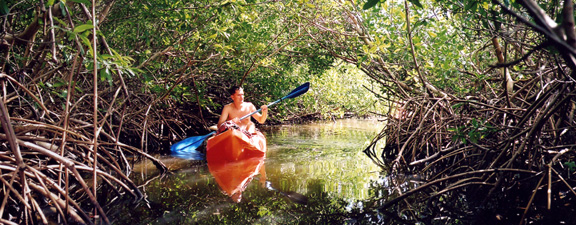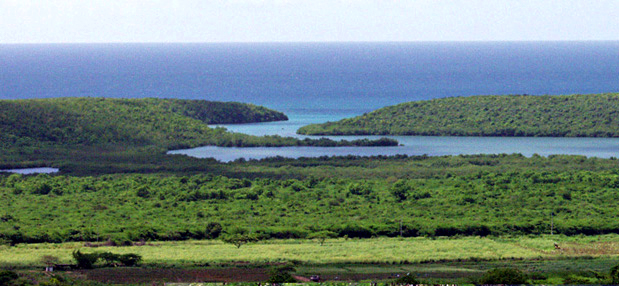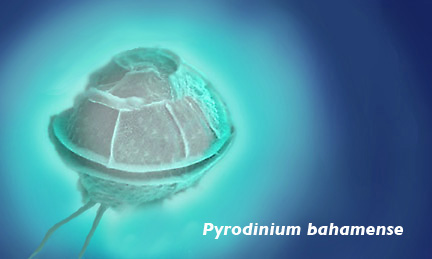A Delicate Balancing Act:
To create a Bioluminescent bay you need a lagoon surrounded by Red Mangroves. The roots of the red mangroves release tannins that are rich in Vitamin B12, one of the important nutrients for these light emitting dinoflagellates. The decomposing mangrove leaves release many other nutrients which add to the nutrient rich environment.
The Bay must also be relatively free of pollution, which generally requires protected lands surrounding the bay.
The Bay requires enough size and depth to enable the water to stay relatively cool in the daytime, it does, however, remain warmer than the ocean outside. It also requires a restrictive channel to the ocean, with a relatively small tidal exchange. This Biobay has the channel to the ocean at the windward end of the bay allowing sufficient water exchange to avoid overheating and stagnancy.
Any alterations to the size of the channel to the ocean (such as shallower or deeper or wider) can destroy a Biobay. Pollution flowing into the bay from chemicals in groundwater and flood waters can ruin a Biobay. Sufficient fluorocarbons from motorboats adversely affects the Bioluminescent dinoflagellates, as would waste from any boats anchored in the bay. People swimming, who have sprayed themselves with DEET, adversely affect the Biobay.
Kayaking in the bioluminescent lagoon:
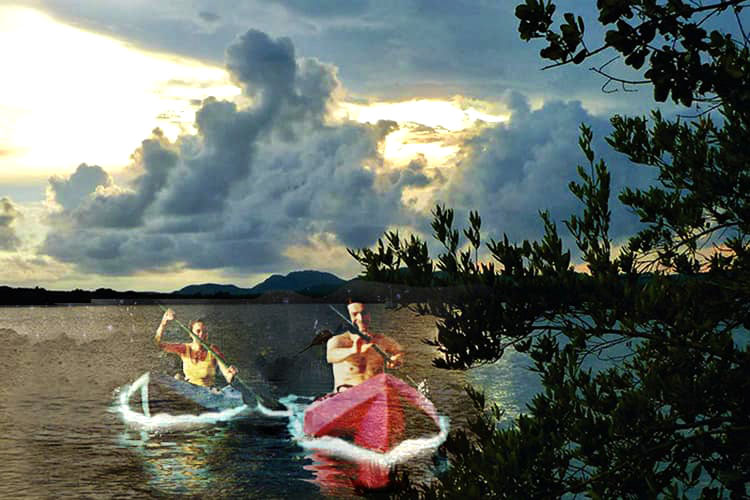
Lights seen from the bay and ambient light in the sky ( reflected from clouds) greatly reduce the visibility of the Bioluminescent at night. It is a real treat to be in the Biobay when the electricity goes out on the island! It is also considerably better to see the Biobay when there is no moon visible in the sky.
So why is this particular Biobay (perhaps) the brightest in the world? Because all these factors are perfectly balanced, creating ideal circumstances for a constant 'super bloom' of Pyrodinium bahamense dinoflagellates, over 700,000 per gallon of water!
How fragile is this ecosystem? Well, the factors being constant, this bay recreates itself continuously (for now). A recent rainfall, of over 30 inches, poured sediment into the bay turning it into a giant mud puddle... and killed most of the dinoflagellates. The sediment flushed out with the tides over a few weeks period, the dinoflagellates reproduced like crazy, and repopulated themselves, and the bay became, just as bright all over again.
The Bioluminescent dinoflagellates Pyrodinium bahamense are a photosynthesis using plankton. They are one celled and measure about 1/500 th of an inch. The tiny burst of light it gives off is a hundred times bigger than itself. ( Above is merely an artists depiction of the glow) Each dinoflagellete bursts into light when it feels pressure against its cell wall. The light is given off in an instantaneous process; when you add the light bursts of 750,000 dinoflagellates per cubic foot of water together the effect is spectacular!
Almost all marine Bioluminescent is (greenish) blue in color, for two related reasons. First, blue-green light (wavelength around 470 nm) transmits furthest in water. The reason that underwater photos usually look blue is because red light is quickly absorbed as you descend. The second reason for bioluminescence to be blue is that most organisms are sensitive only to blue light.
The luminescence of a single dinoflagellate is readily visible to the dark adapted human eye. Most dinoflagellates emit about 6e8 photons in a flash lasting only about 0.1 second. Much larger organisms such as jellyfish emit about 2e11 photons per second for sometimes tens of seconds. The intensity of luminescence by photosynthetic dinoflagellates is strongly influenced by the intensity of sunlight the previous day. The brighter the sunlight the brighter the flash! Which is only emitted at night.
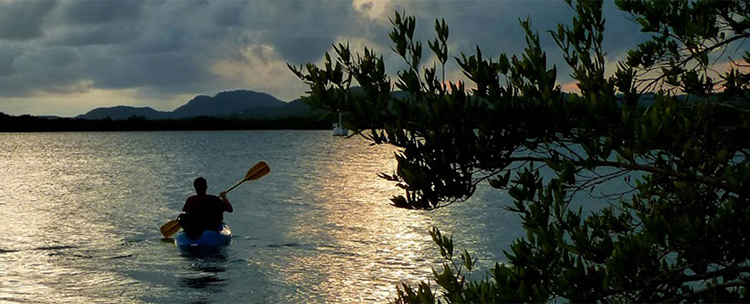
Columbia Encyclopedia:
Bioluminescence is production of light by living organisms.. The dinoflagellates, a group of marine
algae, produce light only when disturbed.. The production of light in
bioluminescent organisms results from the conversion of chemical
energy to light energy. The reaction is mediated by an enzyme, luciferase,
which is normally bound to ATP in
an inactive form. When the signal for the specialized bioluminescent
cells to flash is received, the luciferase is liberated from the
ATP, causes the luciferin to oxidize, and then recombines
with ATP. Different organisms produce different bioluminescent
substances.
The
chemical reaction responsible for the production of light bursts
begins with a luciferin, a light emitter. This chemical is either
acquired through the food chain or synthesized within the organism
itself. Different types of organisms use different luciferins
for their reactions. There are believed to be about six different
types of luciferin molecules. The luciferin reacts with another
chemical, called the luciferase, salt and oxygen resulting in
a burst of light and water.
Luciferin
+ Luciferase + Oxygen + Salt ----> Light + Water
|
